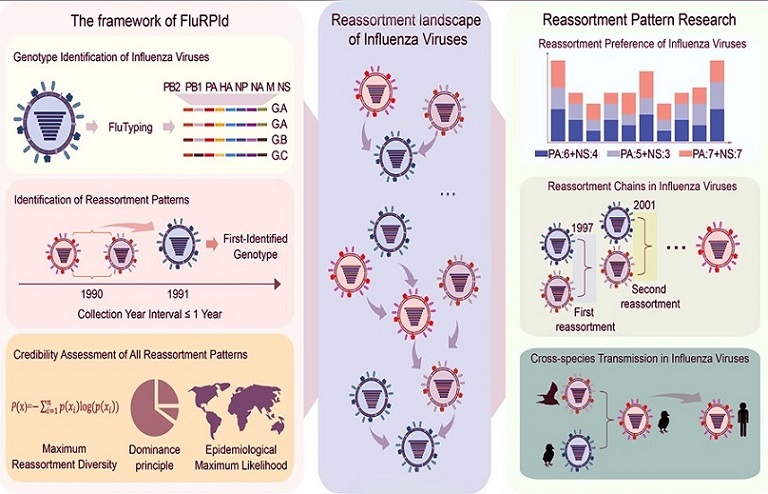Hidden Mechanisms of Bird Flu Evolution Reveal Shocking Cross Species Transmission Patterns
Nikhil Prasad Fact checked by:Thailand Medical News Team May 26, 2025 6 months, 4 weeks, 1 day, 7 hours, 42 minutes ago
Medical News: A groundbreaking study led by researchers from the State Key Laboratory of Common Mechanism Research for Major Diseases at the Suzhou Institute of Systems Medicine, the Chinese Academy of Medical Sciences & Peking Union Medical College, and The Second Affiliated Hospital of Soochow University in China, has revealed how the flu virus is far more cunning than previously thought. Scientists have discovered that influenza viruses evolve through a genetic mix-and-match process called reassortment—and they do so with preference, continuity, and an alarming ability to jump across species barriers.
 Hidden Mechanisms of Bird Flu Evolution Reveal Shocking Cross Species Transmission Patterns
Hidden Mechanisms of Bird Flu Evolution Reveal Shocking Cross Species Transmission Patterns
Schematic diagram of this study. The FluRPId framework, built upon the FluTyping tool, comprises three core components: Genotype identification, RP detection, and credibility assessment. Using FluRPId, we constructed a comprehensive reassortment landscape of influenza viruses, providing a systematic approach for advanced studies, including reassortment preference analysis, the investigation of reassortment chains, and the study of cross-species transmission in influenza viruses.
This
Medical News report unpacks how the research team created a powerful tool called FluRPId to decode how influenza viruses swap genetic segments and form new dangerous strains. The team examined data from over 170000 virus genomes collected from 1932 to 2024, making it the most comprehensive analysis of influenza virus reassortment to date.
FluRPId Identifies Hidden Gene Swaps Behind New Flu Strains
Reassortment happens when two or more influenza viruses infect the same host and exchange parts of their genetic material. The resulting new virus can have entirely different traits, including the ability to infect new species or evade the immune system. The FluRPId system allowed researchers to pinpoint over 12425 of these genetic swap events—many of them previously undetected.
FluRPId uses advanced methods to evaluate the credibility of each reassortment event by considering how often the resulting strains appeared, whether they matched known viruses, and if they could realistically occur based on time and geography. More than 27% of these events were rated highly credible, meaning they likely happened in real-world settings.
Key Genes Prefer to Reassort Together
Interestingly, the study found that not all gene segments mix equally. Certain segments, like NA (neuraminidase), HA (hemagglutinin), PA (polymerase acidic), and NS (non-structural), reassorted more often than others. The NA gene alone was found in over 650 reassortments, suggesting it's a major player in creating new strains. Combinations like HA-NA-NS showed up repeatedly, hinting that these genetic pairings offer evolutionary advantages.
At a more detailed level, the researchers found specific patterns in how these segments combined, including strong connections between certain genetic clades (subgroups of genes with similar muta
tions). This shows that flu viruses are not randomly mutating but following certain “rules” when creating new hybrids.
Viruses Are Sharing Genes Across Species and Spreading Faster Than We Thought
Perhaps the most alarming finding was how these reassortments led to cross-species transmission. The team tracked how viruses that started in birds, such as H7N9 and H5N6, began infecting humans over time. For instance, the virus behind the 2013 H7N9 outbreak in China was traced to a reassortment between bird viruses in 2013. By that year, 40.5% of infections were already in humans. Similar events were observed with H5N1 and H5N6 strains, raising serious concerns about future pandemics.
The most concerning example was a strain of H5N1 that jumped from birds to dairy cows in the U.S. and has already infected humans. Originally detected in birds in 2022, by 2024, nearly three-quarters of these viruses were found in cows, with a small percentage in humans. This shift suggests that the virus is adapting to mammalian hosts—and fast.
A Flu Virus Evolution Map Like No Other
Using FluRPId, the researchers also built a massive network map showing how different strains evolved through multiple reassortments. They identified “hub” strains that have served as parent viruses for many others, showing that some viruses play a central role in driving evolution.
One virus strain was involved in a chain of four reassortment events over a 12-year period, each time combining with different viruses to create new variants. This highlights how influenza viruses not only mutate but build upon earlier swaps to keep evolving in ways that can eventually threaten humans.
Conclusions
This study presents strong evidence that flu virus evolution is not random. Instead, the process follows specific rules of preference and continuity, with certain genes reassorting more often and certain strains acting as evolutionary hubs. Even more concerning, many of these reassortments enable the virus to cross from birds into humans or livestock, increasing the risk of future pandemics. With a virus that adapts rapidly and silently through reassortment, continuous global surveillance and advanced detection tools like FluRPId are crucial to stay ahead of the next outbreak. The findings also suggest that some flu strains may already be positioning themselves for broader mammalian spread—posing serious public health threats.
The study findings were published in the peer reviewed journal: Briefings in Bioinformatics
https://academic.oup.com/bib/article/26/3/bbaf233/8140404
For the latest H5N1 News, keep on logging to Thailand
Medical News.
Read Also:
https://www.thailandmedical.news/news/new-h5n1-genotype-d1-1-that-is-more-lethal-to-humans-found-infecting-dairy-herds-in-nevada
https://www.thailandmedical.news/news/u-s-nih-finds-american-bovine-h5n1-shows-enhanced-neurotropism-compared-to-lethal-vietnamese-human-h5n1-strain
https://www.thailandmedical.news/news/czech-republic-scientists-warn-that-h5n1-bird-flu-virus-is-windborne-and-can-spread-across-several-kilometers
https://www.thailandmedical.news/articles/h5n1-avian-flu
https://www.thailandmedical.news/articles/influenza-or-flu
https://www.thailandmedical.news/pages/thailand_doctors_listings
